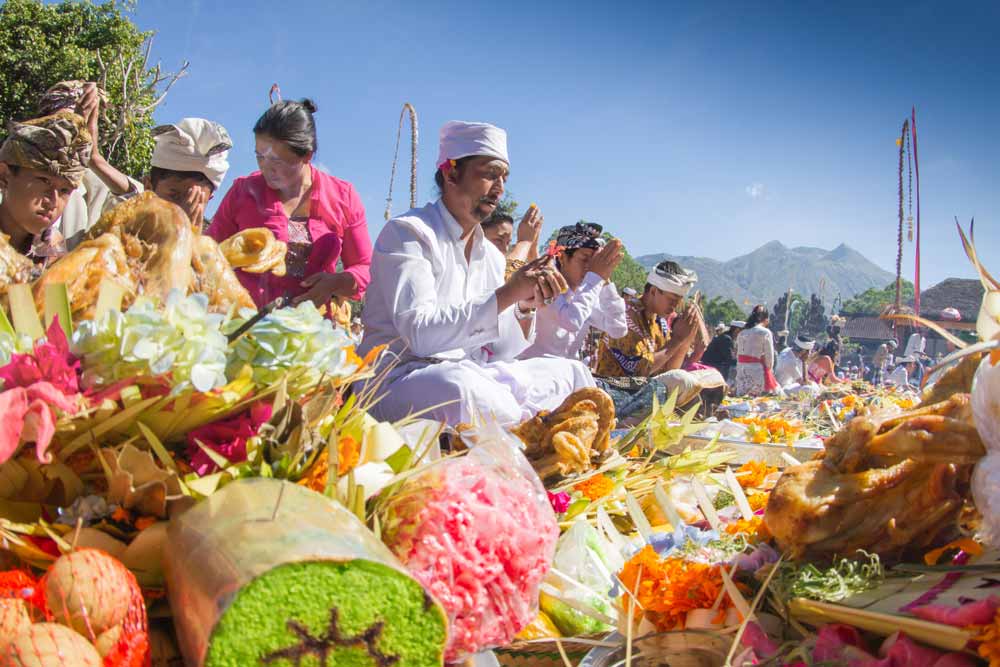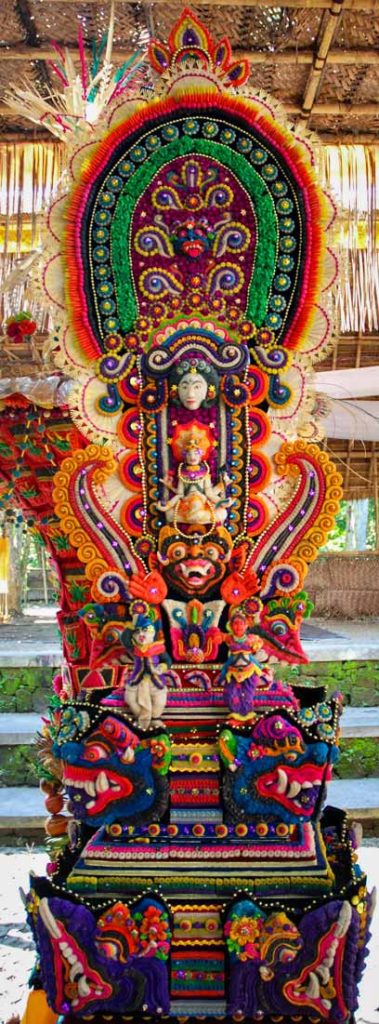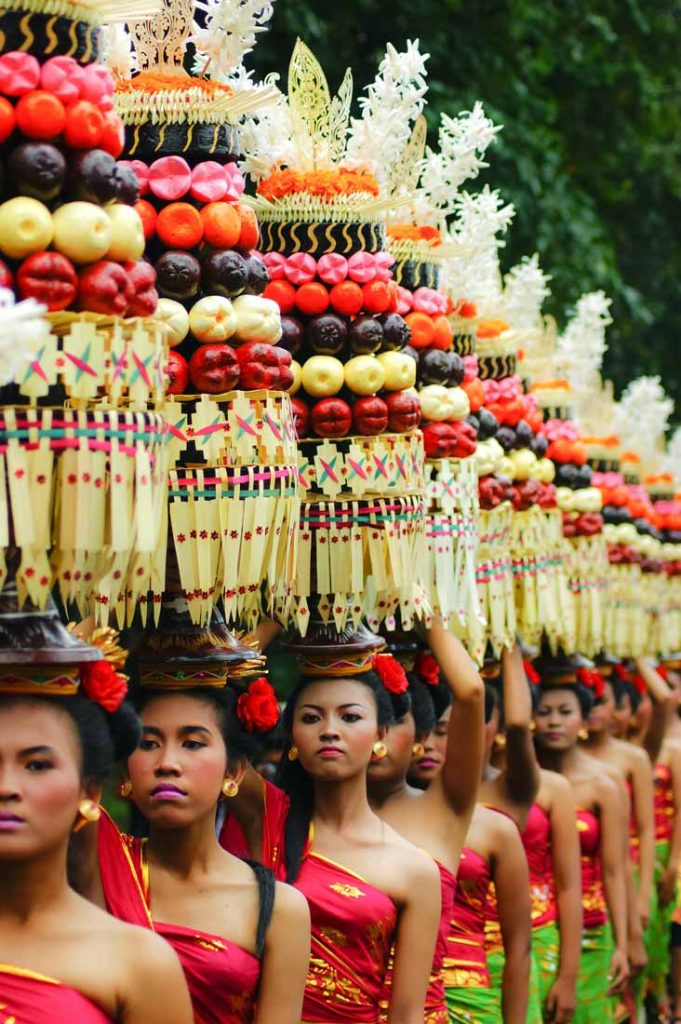
Many of Bali’s top reputed restaurants might sell food of international standards; their diners might be local and international celebrities, ministers, singers and sports stars, but by Balinese standards, believe me, these restaurants don’t quite cut it. Even the ones listed in this magazine. Why is that you ask? Well, they only serve food to humans!
In Bali, the best food is not sold to humans. It is offered to the gods. Forget the Balinese lawar, sambal Bali spices and suckling pig, the best of the best on the island, is not for you or I, but for visitors from the invisible world: gods and ancestors; and for the “worst” of the worst, put on the ground, symbolically “eaten” by the bhuta kala ( “demonic” forces).
All this is not because humans are less demanding than gods and demands, but simply because humans cannot be separated from these two partners. Together, they each occupy their own department in a tripartite world: Bhur, Bhwah and Swah, the earthly, underworld and heavenly realms respectively. And each accordingly must get his or her own share of attention, including their own separate ‘eating quarter’. Let me explain: the restaurant is indeed the eating place for humans, but if you pay attention, you will notice that each restaurant has in its kaja kangin (eastward-mountainward) corner, a small plangkiran shrine in which offerings are addressed to deities. Because it would be improper for humans to eat there while neglecting their duties toward deities. Similarly, the owner of the restaurant, if Balinese, will never forget to put small jotan offerings on the ground as food for the earthly forces.
But the best food to the gods is usually provided in the gods’ restaurants: temples. Welcoming them during temple festivals involves providing them with the best food and the best dances – much like one would with humans. This food is commonly referred to as offerings. The most fantastic is the Sarad cake, symbolising the world, the “Sarad” is made of glutenous rice coloured with natural dyes. Its components may change, but its basic structure and symbolism remains constant. It represents the abode of the gods, the Meru. This Meru is that of the mythical times of the churning of the Milk Ocean, when gods and demons, each pulling at one extremity of the cosmic dragon, used here as a rope, churned the mountain standing in the middle of the sea of milk.
From that churning sprouted the elixir of immortality known as ‘amerta’. In the cake, one always can see, supporting the “mountain” and its gods, the cosmic tortoise, Bedawang Nala, entwined by the dragons and waiting to be churned by them. Above them are usually the three gods of the Hindu Trinity: Brahma is red; Wisnu is black and Iswara is yellow. Then there is Bhoma — the son of Wisnu, born of a rape of the earth goddess Pertiwi, symbol of earth, vegetation; above Bhoma is often the Garuda bird, which killed the dragons and found the elixir of immortality. Above the Garuda is the goose, an animal which feeds in the mud, and is able to separate food from waste. At the uppermost level are Sanghyang Tunggal “the One God” Himself and the Ultimate Atintya. Sometimes, the Meru is made not from glutenous rice, but shaped from pork kebabs and meat. Beware, though, even the pork is not edible.


Yet, in temples, humans get food as well: offerings. These are first taken (usually by women and sometimes in procession) to the temple for a night or a few hours, during which they are symbolically blessed by the presence of the visiting gods and ancestors to which they are addressed. It is after they are taken back home that they may be shared by family members and friends –albeit never friends from a higher caste. The most fantastic of those food offerings are the gebogans, immortalised, time and again, by photographs representing a long, colourful line of women, dressed in their best apparel, looking straight ahead, uptight, each carrying a big offering of fruits and cakes. As all offerings, the gebogan, are laden with symbolism.
Their shape, long and “conical” with a round top, evokes the phallic symbol of Siwa, as well as the related cosmic mountain. But their components too -fruits, cake, flowers, meat- are each related to gods and cosmic functions. More: on top of the gebogan itself are other offerings that also carry each a cosmic signification: a round-shaped sampiang, symbol of the pangider-ider (Balinese “rose of the wind”); and above the sampiang, a small canang offering, a symbol, by its colours, of the rose of the wind too, and, by its porosan (heart), of the Trimurti (gods) Brahma, Wisnu, Iswara. I should add that the flowers of the offerings addressed – on the ground —to demonic (earthly) forces are also laden with cosmic symbolism.
All this, and more, is probably why Balinese food is undoubtedly the most fantastic in the world. If it is not rated five stars, it is not the Balinese’s fault. It is because you don’t understand anything about symbols! Outsiders know only measure the caloric, nutrient and social value of foods and restaurants. You don’t know that gods, ancestors and even demons have to be fed, and thus respected.
What the general public experiences of Balinese culture, down to its food, arts and music, is more and more presented to suit expectations; the iconic expectations of a pristine-yet-modern Bali. Yet, whilst many of us are eating gastronomic global cuisine in Seminyak or elsewhere, ourselves served like royalty in many cases, there are still, more so in the villages of Bali, those that will always give priority to gods and ancestors. May they never surrender to the frenzied consumers of ordinary, human food!






